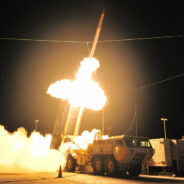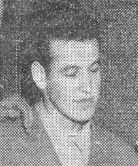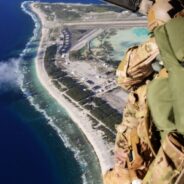Ready, Aim, Fire
Wake Island was the center of action last week when it anchored a test of the U.S. military’s multi-layered, integrated ballistic missile defense system. The irony is inescapable. Wake Island, where the absence of even the most rudimentary radar in 1941 doomed hundreds of Americans to devastating surprise attacks by undetected Japanese bombers, became the base of operations seven decades later for state-of-the-art missile detection and interception technology. The U. S. military confirmed the successful $230 million test on Sunday, November...
read moreOne Got Away
Recently Doug Miller, webmaster at the excellent Pan Am Historical Foundation website, shared a very interesting story with me. Miller was contacted by the son of a Wake Island civilian contractor who had in fact escaped the island aboard the Philippine Clipper following the initial attack by the Japanese on December 8, 1941. In all my research I had never come across any mention of a contractor seizing the opportunity for a ride out that fateful day. But young Tom Cleary did. Mike Cleary shared his recollections of the family story, as well...
read moreNot Forgotten
Last week President Barak Obama proclaimed September 18, 2015, National POW-MIA Recognition day, reinforcing our national commitment to those defenders who never came home. “We rededicate ourselves to our ironclad commitment to never leaving one of our own behind,” the proclamation reads, “and we pay tribute to those patriots known to God and never forgotten.” The quest to locate, identify, and return the remains of our nation’s war dead remains daunting even with the recent reorganization of the agencies responsible for the task and a new...
read moreManhattan Project Proposal
Plans are underway for a Manhattan Project National Historical Park, a joint effort of the Department of Energy and Department of the Interior to link the three sites that developed the atomic bomb during World War II: Hanford, WA; Los Alamos, NM; and Oak Ridge, TN. The two federal agencies are consulting with local political and tribal leaders and community members as they work toward a December 19, 2015, deadline to formally establish the park and present a joint plan for its operation. A draft agreement is open for public review and...
read moreTyphoon Halola
Wake Island dodged a bullet earlier this month. On July 11 a tropical storm formed south of Hawaii near Johnston Atoll and rapidly gained strength as it tracked west toward Wake. The storm packed typhoon-force winds as it approached the atoll and predictions called for a close pass on July 16, prompting a Tropical Cyclone Condition of Readiness 2 on Wake. On July 15 Hawaii Air National Guard evacuated all Wake base personnel to Anderson AFB on Guam via C-17 Globemaster aircraft to wait out Typhoon Halola. The Stars and Stripes website offered...
read moreSorry
A few days ago the Associated Press announced that Japan’s Mitsubishi Corporation apologized to American POWs used as forced labor during World War II. In a ceremony held at the Simon Wiesenthal Center in Los Angeles on July 19, 2015, Mitsubishi senior executive Hikaru Kumura apologized to California veteran James Murphy, 94, the only living survivor able to make the trip, and by extension to all ex-POWs subjected to forced labor by the company during the war. The public apology marks the first time any Japanese company has admitted its...
read moreEaster Island
I recently attended a thought-provoking lecture by Terry Hunt titled “Rethinking Easter Island’s Mysterious Past.” Dr. Hunt, formerly of the University of Hawaii and currently dean of the Clark Honors College and professor of anthropology at University of Oregon (my alma mater), has done extensive research in the archeology and environmental history of the Pacific Islands. For a dozen years Hunt has directed archeological research on Easter Island (Rapa Nui) where his team developed the astonishing theory that the famous giant stone statues...
read moreBlue Book
Anyone connected to the Wake Island civilian contractors’ story either has or wants to have a copy of the “Blue Book,” officially titled A Report to Returned CPNAB Prisoner of War Heroes and their Dependents. The slim volume recounts measures taken to extend wartime relief to dependents and the passage of several public laws during the war to ensure compensation for the captured employees from Wake, Guam, and Cavite, and their families. The enduring appeal of the book, however, is in the nearly eight hundred prewar photographs of the missing...
read moreGuam and Cavite
One of the earliest clues to the story of my father’s wartime past came in the mailbox every month or so when I was growing up: an envelope bearing the return address of the “Survivors of Wake, Guam, and Cavite.” As the years went by I connected a few dots, but Dad never told his story. He had some mysterious scars and debilitating, recurring illnesses relating to the war, but he didn’t talk about it and we knew better than to ask. My father died in 1994 and only after his death did I begin to search in earnest for “what happened to Dad.”...
read morePacific Workhorse: The PBY
Knowing my interest in WWII aircraft, some friends recently forwarded a video about the restoration of a PBY 5A Catalina, a real workhorse of prewar and wartime Pacific air power. Many PBYs landed on Wake Island’s turquoise lagoon in 1941 and the contractors were building the naval air station as a base for this type of plane. The U. S. Navy used the versatile PBYs for patrols, scouting, and when war was underway, for search and rescue operations. Not as flashy as the big wartime bombers and nimble fighter planes, the PBY didn’t capture the...
read more








